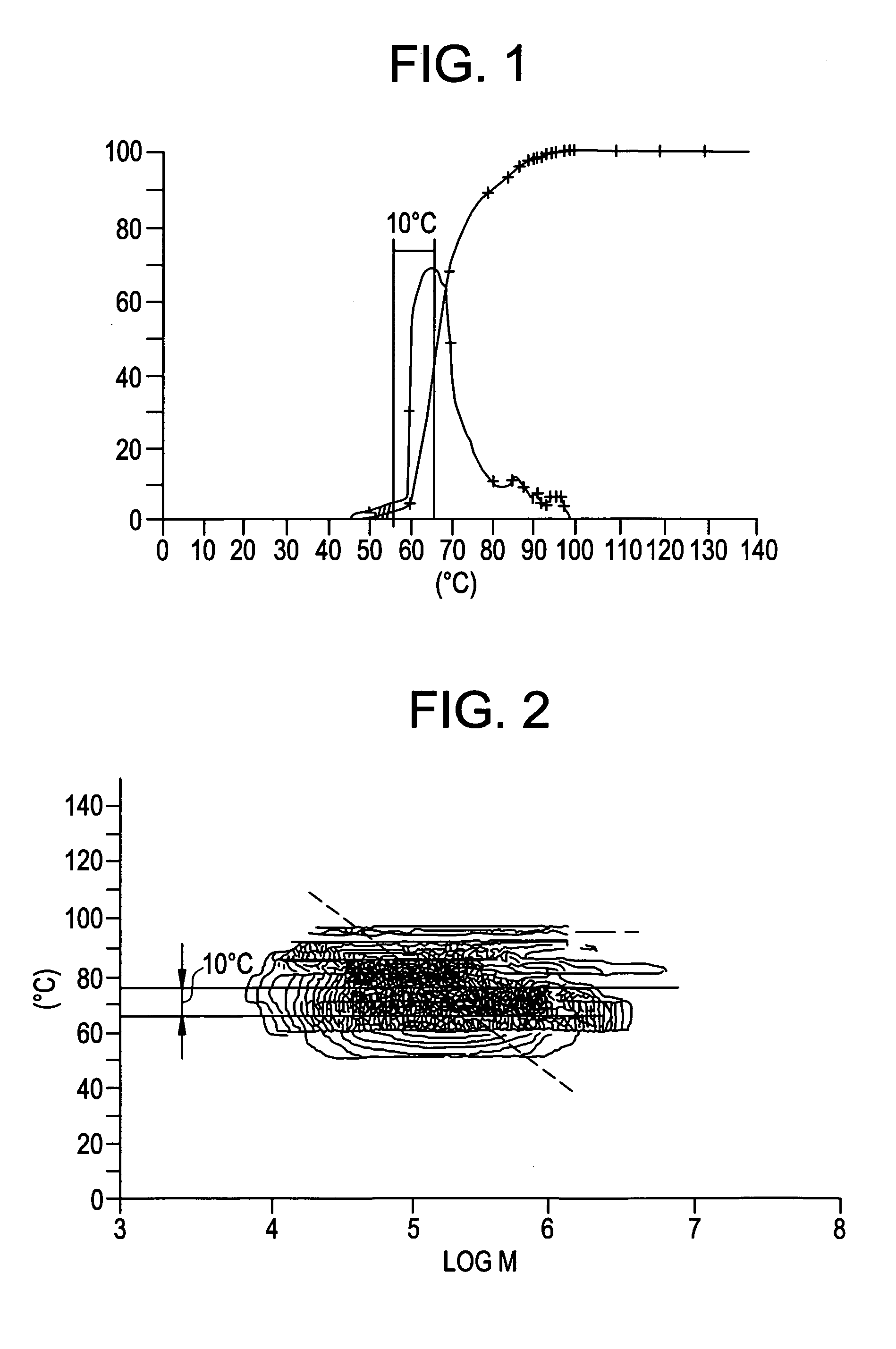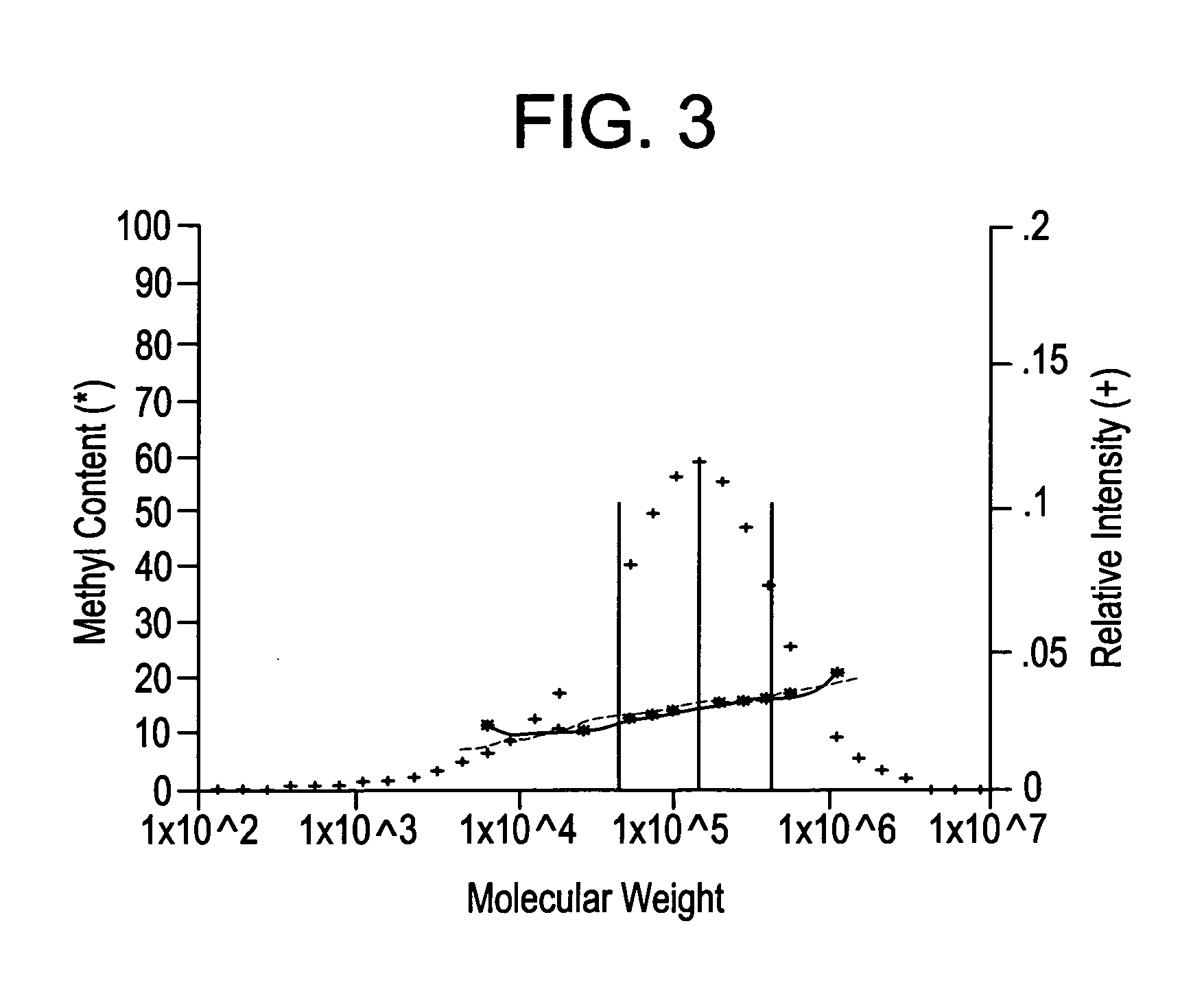Process for preparing copolymers and blend compositions containing the same
- Summary
- Abstract
- Description
- Claims
- Application Information
AI Technical Summary
Benefits of technology
Problems solved by technology
Method used
Image
Examples
example 1
[0459] 20 g of silica SP-9-10046 (manufactured and sold by Grace GmbH, Germany), which had been treated at 250° C. for 2 hours under vacuum, was slurried in 250 ml of toluene. To the resultant slurry was added a solution of 20 ml (0.11 mol) of triethylaluminum in 100 ml of toluene. The resultant mixture was stirred for 2 hours, filtered, washed with two 100 ml portions of fresh toluene and dried under vacuum. The resultant 22 g of dried mixture was slurried in 300 ml of toluene and heated to 70° C. to thereby obtain a slurry. To this slurry was added a solution of 1.25 g (1.77 mmol) of triethylammonium tris(pentafluorophenyl)(4-hydroxyphenyl)borate in 200 ml of toluene which had been heated to and maintained at 70° C. for 30 minutes. Upon addition the heating was removed and the resultant mixture was stirred for 3 hours. After that, a 12.3 ml aliquot of a dark violet colored 0.0714M solution of titanium (N-1,1-dimethylethyl)dimethyl[1-(1,2,3,4,5,-eta)-2,3,4,5-tetramethyl-2,4-cyclope...
examples 2 and 3
[0462] 25 g of silica SP-9-10046 (manufactured and sold by Grace GmbH, Germany)having a water content of 3.5% by weight was added to 508 g of 10% methylalumoxane solution in toluene (manufactured and sold by Witco GmbH, Germany) while continuously stirring. The mixture was stirred for a further two hours and then the solvent was removed under reduced pressure at 20° C. to yield a free-flowing powder. The resulted free-flowing powder was then heated at 175° C. for two hours under vacuum. The resulting powder was re-slurried in 700 ml of toluene and the mixture was washed with two portions of fresh toluene at 100° C. The support was then dried under vacuum at 120° C. for 1 hour. 63.9 g of support was obtained having an aluminum content of 26.4% by weight.
[0463] To 60 gram of the support was added a 33.6 ml aliquot of a dark violet 0.0714 M solution of titanium (N-1,1-dimethylethyl)dimethyl[1-(1,2,3,4,5-eta)-2,3,4,5-tetramethyl-2,4-cyclopentadien-1-yl]silanaminato[(2-)N]-(eta 4-1,3-pe...
examples 4 to 6
[0465] Substantially the same procedures were used as in Examples 2 and 3 to produce the supported catalyst, except that a different MAO treated silica was used wherein the MAO was also immobilized on the silica, but using a different method.
[0466] Substantially the same polymerization procedures as in Example 1 were used, except that the polymerization temperatures and the flow rates of isopentane, 1-butene and hydrogen were changed as indicated in Table 1. The gradient and CFC 1 and CFC 2 data for Examples 4-6 are extrapolates, based on density, from the results of Example 1-3.
[0467] The results of the reactions are shown in Table 1.
PUM
| Property | Measurement | Unit |
|---|---|---|
| Temperature | aaaaa | aaaaa |
| Temperature | aaaaa | aaaaa |
| Fraction | aaaaa | aaaaa |
Abstract
Description
Claims
Application Information
 Login to View More
Login to View More - R&D
- Intellectual Property
- Life Sciences
- Materials
- Tech Scout
- Unparalleled Data Quality
- Higher Quality Content
- 60% Fewer Hallucinations
Browse by: Latest US Patents, China's latest patents, Technical Efficacy Thesaurus, Application Domain, Technology Topic, Popular Technical Reports.
© 2025 PatSnap. All rights reserved.Legal|Privacy policy|Modern Slavery Act Transparency Statement|Sitemap|About US| Contact US: help@patsnap.com



